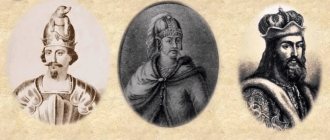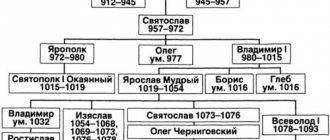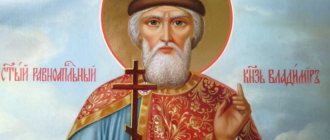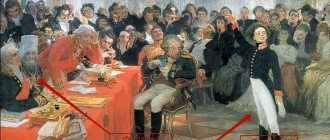Almost everyone knows this person from history. Princess Olga ruled Kievan Rus until 960. It was she who became the first ruler to convert to Christianity. No one knows exactly when she was born. But some sources claim that her death occurred in the eightieth year of her life. At the time of marriage, Olga was about 10 years old. This means that the approximate year of her birth is 893.
Princess Olga became the wife of Prince Igor. After birth, she was named Helga, but her husband decided to give her a different name. She received the name that glorified the woman after her baptism.
In this article we will look at 10 interesting facts about Princess Olga.
There is still debate about its origin
There is still debate about the origin of Princess Olga .
There are many versions on this matter. Some believe that she was a native of Pskov, while others are sure that her birthplace was Izborsk. There is no information about Olga before her marriage. The Tale of Bygone Years says that it was brought to Prince Igor in 903. It is indicated here that the princess was born in the village of Vybutino-Budutino.
Since the girl was born in the north, her roots go back to the Eastern Slavs. They were the ones who lived on these lands at that time. The story contains no information about what Olga did before her marriage to Igor. All that is known is that she was a simple village woman whom the prince met while hunting.
Option 2
In Russian history, Princess Olga is referred to as the Grand Duchess of Kiev. Grand Duchess Olga began to rule in Kievan Rus' after the tragic death of her husband Igor at the hands of the Drevlyans in 945. The exact date of Olga’s birth is unknown, there is only an estimated year, it is 893, and Olga’s birthplace was the outskirts of Pskov.
There is a legend about the meeting of Olga and Igor, according to which the prince was hunting near Pskov and accidentally noticed a girl floating along the river in a boat. And having started a conversation with her, he was rejected. After which, when the question of his marriage arose, he remembered this girl and ordered to find her. And so their wedding took place. And in 942 their son Svyatoslav was born. The heir to the throne, Svyatoslav, was only 3 years old at the time of the death of Igor’s father, so the squad and people recognized Olga as a princess.
At the beginning of her reign, she was determined to take revenge on the Drevlyans for her husband. The Tale of Bygone Years describes 4 different plots of revenge against the Drevlyans. Most of the Drevlyans died, and the rest submitted and surrendered. In the same year, Olga established the official amount of tribute, the timing and frequency of its collection in Kyiv. And in 947 she appointed the collection of tribute in Pskov and Novgorod.
According to the Tale of Bygone Years, Olga was the first of the rulers of Rus' to convert to Christianity. Her baptism took place in 955 in Constantinople. To get baptized, Olga used a little trick. One Tsar of Constantinople wanted to take Olga as his wife, but since she still adhered to paganism at that time, she convinced the Tsar of the need to convert to Christianity and become his godfather. After which he will no longer be able to marry her. Having thus accepted Christianity, Olga encouraged her son Svyatoslav to also be baptized, but he did not betray his beliefs and remained a pagan.
After Svyatoslav became an adult, Olga still continued to rule the state, but not to the fullest extent, since her son was often on military campaigns with his squad. And after Olga became a grandmother, she helped raise her grandchildren.
The Grand Duchess of Kiev died in 969 and was buried according to Christian rites. And later, in 1547, she was canonized. In honor of Princess Olga, monuments were erected in Kyiv, streets, towns, villages, as well as monasteries and cathedrals were named. And historical information describes Olga as a beautiful, cunning and wise woman.
Avenged the death of her husband in 4 stages
Not many people know that Princess Olga took revenge for the death of her husband . She grieved greatly for him, but her strong character did not allow her to remain in this state for long.
After Olga's husband was killed, the Drevlyans decided to send matchmakers to her to ask her to marry. But by order of the princess, the boat on which the guests arrived was taken to the courtyard of the tower. It was there that all the matchmakers were buried alive.
After the first revenge, Olga decided to ask that the best men come to her again for future marriage. When the people arrived, they were burned alive in the bathhouse.
But the princess did not stop there. One day, together with her squad, she arrived in the land of the Drevlyans. During a small meal, Olga gave everyone a drink and ordered her soldiers to cut them down. About five thousand people were killed that day.
The last thing Olga did was burn the capital along with the Drevlyans. During the summer period, she tied Molotov cocktails to the birds, and then sent them to the city where these peoples lived.
Duchess Olga. Mysteries of the biography of the first Russian saint
The famous Princess Olga is a figure no less mysterious than Gostomysl, Rurik and the Prophetic Oleg. An objective study of Olga’s personality is hampered by two seemingly mutually exclusive circumstances. Before the sudden death of her husband, she was just the prince’s wife, that is, a dependent figure, secondary and for the chroniclers (assuming that they already existed at the Kiev court in those days) of little interest. But after the rapid and brilliant appearance of our heroine on the big historical stage and especially after canonization, interest in her personality increased by several orders of magnitude at once, but writing about so many things became inconvenient, and, perhaps, unsafe. As a result, many “unnecessary” fragments of the chronicles were destroyed or cleaned up and replaced with more suitable ones. The accidentally preserved originals burned in numerous fires and were irretrievably lost in the monastery cellars during floods. Ancient, difficult-to-read manuscripts were copied by monks who did not know history, who replaced letters and words they did not understand with others that seemed most suitable to them. When copying manuscripts written in the Glagolitic alphabet, numbers and letters were thoughtlessly repeated without taking into account the fact that in Cyrillic they already mean different numbers. (In the Cyrillic and Glagolitic alphabet, the meanings of only two numbers-letters coincide: a=1 and i=10.) As a result, entire generations of historians fell into despair, trying to figure out the chronology of the events of those years, as well as Olga’s age and her origins. V. Tatishchev, for example, claimed that she was baptized at the age of 68, and B.A. Rybakov insisted that she was between 28 and 32 years old at the time. But the age difference between Olga and her husband Igor is absolutely impressive. If you believe the Joachim Chronicle and some other ancient Russian sources, the picture is as follows. Olga lived modestly and unnoticed in the village of Vydubitsky near Pskov (which, by the way, if you trust some of the same sources, was founded by Olga herself after returning from Byzantium). But, despite her modesty, she was not an ordinary girl, but the eldest daughter of the famous Gostomysl, and in fact her name was Beautiful (they called her Olga later, for her wisdom). Everything would be fine, but only, according to the same chronicles, Gostomysl’s middle daughter Umila was Rurik’s mother. And this alone is very suspicious: why do later chroniclers justify the right to power of both father and son by marrying the daughters of the same leader of the Obodrite tribe? Maybe in the original version of the chronicle Igor was not the son of Rurik? But you cannot erase a word from the lists of ancient chronicles that have reached our time, and therefore in 880, 19-year-old Igor first meets Beauty, who kindly transports him across the river on a boat. And Beauty at this time is about 120 years old. But Igor remembered her and 23 years later (in 903) she married him. She gave birth to Svyatoslav only 39 years later - in 942 - at about 180 years old. And when the princess was about 200 years old, the Byzantine emperor fell in love with her. And then she lived another 12 years. Is it worth it after this to find fault with the information of Russian epics, that Ilya Muromets sat on the stove for thirty years and three years, and Volga Vseslavich stood up on his feet within an hour after birth?
The obvious unreliability of much of the information concerning Olga given in ancient Russian chronicles inevitably pushed researchers to search for information in other historical sources. These were found in the Scandinavian countries. Despite the fierce rejection of these sources by our anti-Normanist “patriots,” their historical significance was, although with difficulty and not immediately, recognized by many conscientious historians. In fact, it was impossible to deny the fact that many historical sagas were written down about a hundred years earlier than the first ancient Russian chronicles that have reached our time, and these sagas were recorded from the words of eyewitnesses, and in some cases - even by participants in the events that took place on the territory of Ancient Rus' . And one cannot ignore the fact that the Scandinavians who returned home did not care at all who was now in power in Kyiv or Novgorod (which, unfortunately, cannot be said about the ancient Russian chroniclers). And many researchers, sooner or later, had to ask themselves a very inconvenient question: why, following the chronicle version, they sometimes in their further work come across a whole series of anachronisms, logical inconsistencies and contradictions, while the version of the Scandinavians that contradicts it fits almost perfectly into the outline of further events?
The first ruler of the Slavs was very well known to the Scandinavians. The unknown author of the "Orvar-Odd Saga" (this is not the most reliable source, not "The Strand of Eymund" and not the "Saga of Ingvar the Traveler" - I know) and the famous Danish historian Saxo Grammaticus claim that Olga was the sister of the Danish king Ingelus, and her name was Helga. And they give a very romantic story about how Igor got it. The matchmaking on the Russian side was allegedly led by the Prophetic Oleg himself (Helgi, Odd). But there was another contender for the princess’s hand - the leader of the Danish berserkers, Agantir, who challenged Oleg to a duel, which ended in the victory of our prince. Oleg had experience fighting berserkers. Fighting for Aldeygyuborg (Old Town - Ladoga) with the sea king Eirik, in whose squad was the berserker Grim Egir, who was considered invincible, known under the nicknames “Giant of the Sea” and “Sea Serpent”, he personally killed Egir. But this experience in no way guaranteed another victory. It would have been much simpler and more logical to entrust the fight to one of the veterans who had been tested in dozens of battles—Oleg’s squad had plenty of them. But he doesn't trust it. It is unknown for what reason, but the prince needed Olga and only Olga as a wife for Igor. It is needed so much that he, without hesitation, risks his life. Or maybe it was the other way around? Is it not Igor who needs Olga as a wife, but Olga who needs Igor as her husband?
The version of Olga’s Scandinavian origins has traditionally been hushed up in our country. Since this hypothesis has not been confirmed in other sources, historians loyal to the Scandinavians still do not insist on it. But if previously the main and almost the only version of the Slavic origin of the famous princess was considered, now more and more attention of researchers is being attracted by the “synthetic version”, according to which Olga was allegedly born on the territory of Rus', near Pskov, but “was of Varangian descent.” The sources on which the authors of this hypothesis rely are also available and well known to specialists. Undolsky's handwritten Synopsis, for example, states that Olga was not only “of the Varangian language,” but also “Oleg’s daughter”!
If you believe this for a couple of minutes, it will become clear why Oleg personally goes out to fight Agantir. From the point of view of a wise Norwegian, a half-crazy berserker without family and without a tribe cannot be a good match for his daughter. The young Prince Ingvar is a completely different matter, isn’t it?
The assumption that Olga was “of the Varangian language” is confirmed in ancient Russian chronicles. In the fragments of Olga's speeches preserved by the chroniclers, there are obvious Scandinavianisms. For example, Olga reproaches the Byzantine ambassadors who arrived in Kyiv for the fact that in Constantinople she “stood before the emperor in scutari in court.” Skuta, translated from Old Norse, means a single-masted ship, and sund means strait. That is, the Byzantines kept her and her entire retinue on boats in the strait and did not even allow her to go ashore. Moreover, she says this in a fit of irritation, when the words are not chosen, but are pronounced by the first ones that come to mind, and, therefore, the most familiar. In the same chronicles one can find some other crumbs in favor of the Varangian origin of the princess. Tradition claims that young Olga, while her parents were still alive, was given to her aunt to raise - an act that was extremely rare in Rus', but common in Scandinavia during the Viking Age. And Olga takes revenge on the Drevlyan ambassadors entirely in the Scandinavian spirit - revenge through funeral rites is a favorite motif in Scandinavian sagas. And versions of the legend about the burning of the city with the help of birds can be read in both Saxo Grammar and Snorri Sturlson. If in the story of this revenge the Russian names were replaced with Scandinavian ones, it could very easily be mistaken for an excerpt from an Icelandic family saga.
What follows is even more interesting, since the author of the Synopsis calls Olga’s father “Prince Tmutarakan of Polovtsian”(!). It would seem difficult to imagine a more absurd situation: in the 10th century, Polovtsians living in Rus' spoke the Varangian language! After all, it is well known that the Polovtsians were a Turkic-speaking people, and their first meeting with the Russians is precisely dated 1055: “Come Blush from the Polovtsians and create peace for Vsevolod (the son of Yaroslav the Wise, who died a year earlier) ... and return (the Polovtsians) home.” And what kind of Dark Roach is this? What does he have to do with Oleg? However, despite the seemingly obvious contradictions, there is something to think about here. With the same Tmutarakan, for example, no special problems arise: Tarkhan is not a name, but a position: the leader of a thousand warriors. Well, Tmutarkhan is already something like a generalissimo. Could the chronicler call our Prophetic Oleg that? Probably he could, and very easily. All that remains is to figure out why Oleg Generalissimo is not Varangian, and not Russian, but Polovtsian. Here we are clearly dealing with an aberration of memory: the Polovtsians are known more than well to the author of the Synopsis, but their predecessors have already somehow been forgotten. Let's not find fault with the author: for a person who knows something about the history of Kievan Rus, he said quite enough. Let’s try to define the “Polovtsians” of the 10th century ourselves. The Pechenegs are clearly not suitable for the role of leaders of the steppe world, since in the time of Oleg they themselves had recently come to the Black Sea steppes and were subordinate to the Khazars. They gained strength after the collapse of the Kaganate. But the Khazars... Why not? Chronicles claim that Oleg saved a number of Slavic tribes from Khazar tribute, replacing it with tribute for his beloved. It seems that the chroniclers are being somewhat disingenuous in this case: most likely, Oleg played the role of Ivan Kalita, who became terribly rich by promising the Tatars to personally collect taxes for them from all other principalities. The first prince who decided to throw off the Khazar yoke was, it seems, not Oleg, but his pupil Igor. Moreover, it was precisely this desire that probably led to his death. Incited by the Byzantines, in 939 he captured the Khazar fortress of Samkerts. The response to this challenge was the punitive expedition of the Khazar commander Pesach (940). As a result, Igor was forced to conclude a difficult truce, the main conditions of which were “tribute by swords” (the Russians were simply disarmed) and the war against Byzantium in 941. “And Helg (Igor’s real name, it seems, was Helgi Ingvar - Oleg the Younger) went against freedom and fought at sea against Constantinople for 4 months. And his heroes fell there, because the Macedonians overpowered him with fire” (“Judeo-Khazar Correspondence”). In 944, Igor, apparently under pressure from Khazaria, tried to take revenge, but the memory of the recent defeat turned out to be stronger than the fear of the Khazars, since, having taken a relatively small payoff from the Byzantines, the prince, without bringing the matter to battle, returned to Kyiv . The fact that the Byzantines really did not show generosity in this case is evidenced by the further course of events: the situation with public finances in Kyiv was so deplorable that in 945 Igor decided to take a truly desperate step - to take tribute from the Drevlyans twice. The Drevlyans, naturally, did not like this: they “tied Igor to the tops of two bent trees and tore him into two parts” (Leo the Deacon). But what about the Prophetic Oleg who supposedly “liberated the Slavs from the Khazar yoke”? Oleg, according to A.K. Tolstoy’s definition, was “a great warrior and an intelligent man.” Therefore, he did not strive to achieve unrealistic goals and, apparently, was quite content with the role of a vassal of the great Khazaria, which at that time successfully resisted both the Arab world and Byzantium. Therefore, his contemporaries, perhaps, could have called him the Khazar Tmutarkhan. By the way, in the Radzivilov Chronicle there is a drawing - Oleg is fighting in the Balkans. And on its banner the Arabic inscription “Din” is clearly readable - “faith”, “religion”. This inscription could only appear if Oleg led the united Russian-Khazar troops, making a campaign on behalf of the Khazar Kaganate, the main fighting force of which had always been mercenary Muslim units.
But let's return to Olga. After the death of her husband, with a firm hand she restored order to the territory under her control. According to the chronicles, the princess personally toured her possessions, established rules and order in all zemstvo affairs, determined quitrents, designated areas for catching animals, and set up graveyards for trade. Then she made her brilliant debut on the international stage when, through her baptism in Constantinople, she managed to establish diplomatic relations with the still strong eastern empire. Olga’s character, apparently, was not a weak one, and she retained power over Kiev and the lands subject to it even when her son Svyatoslav grew up and matured. The formidable warrior prince seemed to be a little afraid of his mother, and tried to spend all his free time away from the stern eyes of his parents. Being a legitimate prince, he did not even try to rule in Kyiv, trying with all his might to win a new principality in Bulgaria. And only after being defeated, he publicly declared his desire to “seriously” reign in Kyiv. To show everyone “who’s boss,” he ordered the execution of the Christian soldiers who were in his squad (attributing blame for the defeat to them), sent an order to Kiev to burn churches and announced that upon returning to the capital he intended to “ruin” everyone Russian Christians. According to L. Gumilyov, with this he signed his own death sentence: until then, the governor Sveneld, loyal to him, suddenly took most of the squad across the steppe to Kyiv, and probably let the Pechenegs know about the route and time of Svyatoslav’s journey. The accusation, of course, is unprovable, but very justified: this information is too confidential, neither the frightened Kyivians nor the Byzantine Emperor John Tzimiskes, to whom the chronicle attributes the notification of the Pechenegs, could have possessed it. A very interesting question: to whom did Sveneld go? Who was waiting for him in Kyiv? Let us recall that after the death of Igor, “Svyatoslav was kept by his breadwinner or uncle Asmold (Asmund).” But Sveneld was Olga’s man: “he protected the princess, the city, and the whole land.” If you believe ancient Russian sources, then Sveneld hurried to Svyatoslav’s eldest son, Yaropolk, who converted to Christianity, whose chief adviser and governor he soon became.
But it's not that simple. Yes, according to many chronicles, Princess Olga died either in 967 or 969: during Svyatoslav’s lifetime she was solemnly mourned and buried with honor. But the authors of some chronicles apparently did not know or forgot about this sad event, since they describe a conversation between Svyatoslav and his mother that took place after her “official” death. I wonder where and under what circumstances such a conversation could take place? The Scandinavians claim that the princess outlived not only Svyatoslav, but also Yaropolk: at the court of the pagan prince Valdamar (Vladimir), Olga enjoyed great respect and was considered a great prophetess. It is possible that, even at an advanced age, Olga, with the help of people loyal to her, managed to protect both herself and the Kyiv Christians from the wrath of her formidable and unpredictable son.
But why did the ancient Russian chronicles bury Olga “alive”? Scandinavian sources claim that Olga prophesied “by the spirit of Phyton” (Python!). Did our princess really not only go to churches in Constantinople, but also find time to look somewhere else? Did you remember in your old age? If this is true, then, of course, it would have been better to keep silent about such a hobby of the first Russian saint - out of harm’s way: she died in 967 or 969 and that was the end of it.
Laid the beginning of stone urban planning
Princess Olga became the person who laid the foundation for stone town planning . The very first buildings made of stone were the city palace and the lady's tower outside the city.
She tried to pay special attention to the construction of Kyiv and the lands that belonged to it. This is how she was able to make her invaluable contribution to the history of Rus'.
Advantages and disadvantages
Achievements and successes
- The uprising of the Drevlyans was suppressed (946).
- The first administrative and tax reform in Rus' was carried out (947).
The lands subject to Kyiv were divided into administrative units - graveyards, in each of which a princely administrator - tiun - was appointed; collection of tribute (lessons) was introduced; the amounts of “polyudya” - taxes in favor of Kyiv, the terms and frequency of their payment - “rents” and “charters” were established. The streamlining of taxation established internal peace in the country for a long time. - According to the chronicle and other sources, in Olga’s era there were 30 years without civil strife and uprisings
(947-977),
about 30 years without invasions
(939-968),
20 years without external wars
(944-964), thanks to which
the economy flourished and trade
_ - Novgorod, Pskov and Rostov were built on modern sites and became major urban centers
after the reform of 947. - The beginning of stone construction in Russia was laid
(the first stone buildings in Kiev were the city palace and Olga’s country tower). - The first official foreign visit of the ruler of Russia
was made - Olga's trip to Constantinople, the capital of Byzantium (955 or 957),
diplomatic relations were established with Byzantium
(Roman Empire)
and Germany
(Holy Roman Empire) (959).[3] - The first woman and the first Christian among Russian rulers
(baptized in 955 or 957),
the first Russian saint
(one of 6 women in history recognized as early apostolic saints). - Olga’s last major achievement in her lifetime can be considered the successfully withstood siege of the Pechenegs in Kyiv during their first raid on Rus' in 968, when one young Kiev resident managed to get through the enemy camp and call for help from the other bank of the Dnieper. This happened already during the independent reign of Svyatoslav Igorevich.
Mistakes and failures
- The uprising of the Drevlyans was suppressed with legendary cruelty, described in the chronicles (during this period, Olga was still a pagan and was extremely dependent on the predominantly pagan princely army).
- Olga was unable to persuade her son Svyatoslav to accept Christianity, which is why her plans to Christianize Rus' were thwarted (the mission of Bishop Adalbert from the Holy Roman Empire, which she called in 959, was forced to go home in 962; on the other hand, this ultimately strengthened the leading the role of Eastern rather than Western Christianity in Rus'); soon after this, Svyatoslav began to rule independently, and after the death of his mother, according to the controversial Joachim Chronicle, during and after the war with Byzantium, he launched a persecution of Christians and killed his Christian brother Uleb (the youngest son of Olga or the son of Igor from another wife).[ 2]
The first of the rulers of Rus' to convert to Christianity
Long before Olga accepted Christianity, she studied its basics. She tried to visit Orthodox churches from time to time and was amazed at their beauty and splendor. Princess Olga became the first woman to convert to Christianity in pagan Russia .
It is worth noting that she tried to involve her son in this, but, unfortunately, she could not. He accepted a different faith. The princess failed to ensure that Christianity was adopted throughout Rus', but her grandson was able to accomplish this. Prince Vladimir continued his difficult mission.
Results of the board
It would seem that Olga's reign began with rather cruel actions on her part. However, the people did not have any hatred for her; on the contrary, she was long remembered as Olga the Wise. The state in which she received the principality required immediate and decisive measures. Having established peace in her principality, Olga set about improving it. Under her, there were no bloody wars, trade flourished, and cities grew. The people bitterly mourned the strict but fair ruler, under whom Rus' lived a peaceful life for 20 years.
Emperor Constantine of Byzantium became her godfather
In different sources you can find completely different information about who baptized Princess Olga. According to one version, this was done by Patriarch Polyeuctus, and according to another, Theophylact. There is also information that Emperor Constantine Porphyrogenitus became the princess’s godfather .
During baptism, a crucifix was placed on Olga, on which Our Lord Jesus Christ was crucified. It is believed that his woman took him to Rus'.
The chronicle also reports that Olga was very smart. The Emperor really wanted to marry her. But the princess said that this was impossible due to the inconsistency of his faith. After the baptism was performed, the woman again refused him because he was her godfather.
Ancient Rus': Olga's reforms
Princess Olga directed her main forces to domestic politics. She carried out several reforms, including administrative and tax reforms: she established trade and exchange centers in which taxes were collected in an orderly manner. The financial system became a strong support of princely power in lands far from Kyiv.
The defensive power of Rus' has increased. Strong walls grew around cities, and the first state borders were established in the west.
The princess strengthened international ties with Byzantium, and relations with Greece opened Olga to a new perspective on the Christian faith. In 954, the princess went to Constantinople for the purpose of a religious pilgrimage and a diplomatic mission, where she was received with honor by Emperor Constantine VII Porphyrogenitus.
Construction of Orthodox churches began
After her return to Kiev, Princess Olga ordered the construction of churches in all graveyards . She was so inspired by visiting such places.
Many temples were built during this period. These include the church in honor of St. Nicholas in Kyiv, as well as the church in honor of the Feast of the Annunciation of the Blessed Virgin Mary in the city of Vitebsk.
During the siege of Kyiv by the Pechenegs, she personally led the defense of the city
History says that in 969, the Byzantines bribed the Pechenegs. They raided Kyiv. At that moment, only Olga and her 3 sons were in the city. Then it was Princess Olga who had to lead the defense. Together with her army, she was able to besiege the Pechenegs, who came to these lands for the first time . Enemies began to attack from all sides, but the woman was very smart and cunning.
She managed to send the young man to the other side, where her son, Prince Svyatoslav, was. He knew the enemy's language and was able to pretend to be one of them.
The trick was a success; the prince and his retinue came to the aid of Kyiv. The Pechenegs were completely defeated.
Activities of the ruler
It seemed that revenge had already been taken, but the princess saw everything in the long term and could no longer expose herself and Svyatoslav to mortal danger from raids from the Drevlyans. She gathered a small squad and went to the enemy’s camp in person in order to convince them that she was satisfied with the put forward terms of peace. In honor of this event, the parties organized a large celebration. Having drunk her opponents, Olga gave the order to her soldiers to destroy the Drevlyans. The number of opponents cut down by the Kyivians reached five thousand.
Without allowing the enemy to come to his senses, the princess undertook a military campaign against the Drevlyan capital, the city of Iskorosten. By the way, the young Svyatoslav also took part in this campaign. Having laid siege to the walls of Iskorosten with her retinue, the princess made several attempts to storm, but were unsuccessful. But even here Olga’s ingenuity did not let her down. Having ordered to catch all the pigeons and sparrows, she tied burning rags to their legs and released them into the city. The birds returning to their nests started a fire in the fortress, destroying it almost to the ground. Thus ended the revenge of the Princess of Kyiv for her husband.
Thanks to this, Olga showed all her strengths, strengthening her position among soldiers and ordinary people. This was followed by several years of successful reign, interspersed with a few and successful campaigns against their closest neighbors. With her policy the princess succeeded:
- subjugate nearby properties;
- establish a relatively developed system of administration and tax collection.
Now each region during the years of Olga’s reign was obliged to pay tribute in a certain amount and on a set date, which not only strengthened the economic well-being of Kyiv, but also did not disrupt the development of taxed lands.
It can be said that Olga was the first to apply and put into circulation an improved tax system, which made it possible to accelerate the development of Kievan Rus and the lands belonging to it. Many history textbooks do not pay due attention to the character and will of Princess Olga, whose brief biography omits bloody revenge on the Drevlyans.
This may be regarded as cruelty, but the trends of the time did not provide any other possible outcome of events.
Continued to rule unofficially when her son was away on campaigns
Very often, Prince Svyatoslav, together with his army, went on various campaigns. Some of them took quite a long period of time. But Kyiv could not remain completely without protection and a ruler.
That is why the princess continued to rule Kievan Rus, but not officially . She also did this until her son reached age and ascended the throne.
She is considered a saint and is considered the patroness of widows and converts.
Olga felt her death approaching in 969. At the end of her life, she was able to persuade her son not to leave Kyiv, but to stay to bury her.
Everyone mourned the princess. subsequently canonized by the Russian Orthodox Church . She became the only saint equal to the apostles.
Every year her memory is celebrated in the church. According to the Julian calendar, this occurs on July 11th. It is worth noting that Princess Olga is considered the patroness of all widows and converted Christians. Very often people turn to her for help with prayers.
Olga was revered earlier and is still revered today. Many girls who have this saint as their heavenly patrons are named after her.
Beginning of reign
Prince Igor of Kiev spent a lot of time on military campaigns, raiding neighboring lands. The couple were often separated and lived separately for a long time. There is an opinion that Igor had several more wives in different lands, but for that time this was commonplace. Despite this, only Princess Olga presented an heir to the Rurikovichs.
In one of the raids on the neighboring Drevlyan lands, Prince Igor was vilely killed. Chronicles say that the main causes of his death were carelessness and greed. Already returning from a successful campaign with the loot, intoxicated by his success, Rurikovich decided to return to one of the villages in order to double the wealth received. But the Drevlyans, who learned about the prince’s small detachment, waylaid him and treacherously killed him.
By right of inheritance, power passed to Igor’s son, Svyatoslav, but due to his young age, the actual control of the state went to Olga. History knows many examples of when power and the reins of government went to women, but not everyone could use it correctly, doubling the power and prosperity of their state.
As for Princess Olga, due to her strong character, strong will and immense love for her late husband, she became one of the greatest rulers of Rus' and is considered the main pillar in the formation of the state.
Cathedrals and temples are named in her honor, as well as three orders.
Currently, many temples, cathedrals, churches have been built, which are illuminated in honor of the Holy Equal-to-the-Apostles Princess Olga.
One of these churches is located in Ostankino. It was built in 2011. Every Tuesday, prayer services are held here, as well as the reading of an akathist to the great Olga.
The Order of Princess Olga is an award for women who have made merit in the state, as well as civil, scientific, educational or other fields. There are three orders - I degree, II and III. The first is made of silver and has a shape resembling an oval. The second one is not much different from the first. The only difference is the depiction of the princess on it. The third degree order is made of silver-plated tombac (a type of brass).
8 3
Origin and early life
The date of birth of Princess Olga of Kyiv is not known for certain, since different chronicle sources indicate different numbers. For example, the Book of Degrees states that she was born at the end of the 9th century, but other sources that record the dates of her wedding, the birth of her son and her death completely contradict these statements.
So, in the “Arkhangelsk Chronicler” it is said that she was married at the age of ten, and died at the age of 75, which suggests a conclusion about the date of her birth from approximately 893 to 928. Official sources and historians still believe that Olga was born in 920.
Nothing is known for certain about the parents of the Equal-to-the-Apostles Princess. Some claim that Olga was from a noble family, others believe that the future ruler of Rus' was raised by commoners, which is why the names of her parents are unknown. There is also a bold assumption that Princess Olga of Kiev was the daughter of the Prophetic Oleg himself, but this is only a version not confirmed by facts. In the Tale of Bygone Years, the princess’s birthplace is listed as the village of Vybuty, located in the Pskov region .
If you believe this same unverified version, then the Prophetic Oleg introduced Prince Igor Rurikovich to Olga, but, most likely, this is fiction. More accurate sources and the life of the holy Equal-to-the-Apostles Princess Olga say that she met her future husband at the crossing, where she worked, dressed in men's clothing.
The young prince needed to cross the river while hunting and he spotted a boat. When the prince saw through the forgery and realized that in front of him was not a man, but a beautiful girl, he tried to show her some signs of attention, receiving a harsh rebuff. Such willfulness struck Igor no less than the girl’s beauty.
When the time came for Prince Rurikovich to look for a wife, he remembered the beautiful ferrywoman who had so deeply disturbed his soul. Then he sent his messengers to that village to find the girl, which was not difficult, because Olga was distinguished by her special beauty, strength of character and wisdom, disproportionate to her years. So subsequently an alliance was concluded between Prince Igor and Princess Olga, which, however, was not destined to last long.










